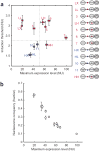A quantitative model of transcription factor-activated gene expression
- PMID: 18849996
- PMCID: PMC2696132
- DOI: 10.1038/nsmb.1500
A quantitative model of transcription factor-activated gene expression
Abstract
A challenge facing biology is to develop quantitative, predictive models of gene regulation. Eukaryotic promoters contain transcription factor binding sites of differing affinity and accessibility, but we understand little about how these variables combine to generate a fine-tuned, quantitative transcriptional response. Here we used the PHO5 promoter in budding yeast to quantify the relationship between transcription factor input and gene expression output, termed the gene-regulation function (GRF). A model that captures variable interactions between transcription factors, nucleosomes and the promoter faithfully reproduced the observed quantitative changes in the GRF that occur upon altering the affinity of transcription factor binding sites, and implicates nucleosome-modulated accessibility of transcription factor binding sites in increasing the diversity of gene expression profiles. This work establishes a quantitative framework that can be applied to predict GRFs of other eukaryotic genes.
Figures





Similar articles
-
Chromatin-dependent transcription factor accessibility rather than nucleosome remodeling predominates during global transcriptional restructuring in Saccharomyces cerevisiae.Mol Biol Cell. 2009 Aug;20(15):3503-13. doi: 10.1091/mbc.e09-02-0111. Epub 2009 Jun 3. Mol Biol Cell. 2009. PMID: 19494041 Free PMC article.
-
DNA Topoisomerases maintain promoters in a state competent for transcriptional activation in Saccharomyces cerevisiae.PLoS Genet. 2012;8(12):e1003128. doi: 10.1371/journal.pgen.1003128. Epub 2012 Dec 20. PLoS Genet. 2012. PMID: 23284296 Free PMC article.
-
Activator control of nucleosome occupancy in activation and repression of transcription.PLoS Biol. 2008 Dec 23;6(12):2928-39. doi: 10.1371/journal.pbio.0060317. PLoS Biol. 2008. PMID: 19108605 Free PMC article.
-
Transcription factors vs nucleosomes: regulation of the PHO5 promoter in yeast.Trends Biochem Sci. 1997 Mar;22(3):93-7. doi: 10.1016/s0968-0004(97)01001-3. Trends Biochem Sci. 1997. PMID: 9066259 Review.
-
The yeast PHO5 promoter: from single locus to systems biology of a paradigm for gene regulation through chromatin.Nucleic Acids Res. 2014;42(17):10888-902. doi: 10.1093/nar/gku784. Epub 2014 Sep 4. Nucleic Acids Res. 2014. PMID: 25190457 Free PMC article. Review.
Cited by
-
Unwinding and rewinding the nucleosome inner turn: force dependence of the kinetic rate constants.Phys Rev E Stat Nonlin Soft Matter Phys. 2013 Jan;87(1):012710. doi: 10.1103/PhysRevE.87.012710. Epub 2013 Jan 17. Phys Rev E Stat Nonlin Soft Matter Phys. 2013. PMID: 23410362 Free PMC article.
-
Reverse Engineering of Genome-wide Gene Regulatory Networks from Gene Expression Data.Curr Genomics. 2015 Feb;16(1):3-22. doi: 10.2174/1389202915666141110210634. Curr Genomics. 2015. PMID: 25937810 Free PMC article.
-
Hog1 controls global reallocation of RNA Pol II upon osmotic shock in Saccharomyces cerevisiae.G3 (Bethesda). 2012 Sep;2(9):1129-36. doi: 10.1534/g3.112.003251. Epub 2012 Sep 1. G3 (Bethesda). 2012. PMID: 22973550 Free PMC article.
-
Biomolecular computing systems: principles, progress and potential.Nat Rev Genet. 2012 Jun 12;13(7):455-68. doi: 10.1038/nrg3197. Nat Rev Genet. 2012. PMID: 22688678 Review.
-
Linking stochastic fluctuations in chromatin structure and gene expression.PLoS Biol. 2013;11(8):e1001621. doi: 10.1371/journal.pbio.1001621. Epub 2013 Aug 6. PLoS Biol. 2013. PMID: 23940458 Free PMC article.
References
-
- Cyert MS. Regulation of nuclear localization during signaling. J Biol Chem. 2001;276:20805–20808. - PubMed
Publication types
MeSH terms
Substances
Grants and funding
LinkOut - more resources
Full Text Sources
Molecular Biology Databases

